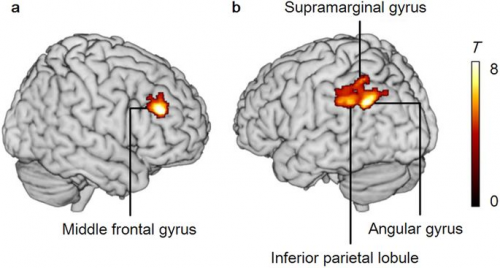Abstract
Perceptual changes in shape, size, or color are observed in patients with derealization symptoms; however, the underlying neural and molecular mechanisms are not well understood. The current study explored the relationship between neural activity associated with altered colorfulness perception assessed by fMRI and striatal dopamine D2 receptor availability measured by [11C]raclopride PET in healthy participants. Inside an fMRI scanner, participants performed the saturation adaptation task, where they rated how much vivid/faded visual objects looked like real/unreal ones using a visual analog scale. We found that participants experienced greater unreality when they perceived fadedness than vividness despite physically identical saturation. The combined fMRI and PET analyses revealed that the faded perception-related activities of the dorsolateral prefrontal and parietal cortex were positively correlated with striatal D2 receptor availability. This finding may help to understand the neuromolecular mechanisms of faded perception associated with feeling unreal in derealization symptoms.
Image

Brain activity of subjective fadedness (a, b) was associated with striatal dopamine D2 receptor availability.
Reference
Neuromolecular basis of faded perception associated with unreality experience
Keita Yokokawa,1,2 Takehito Ito,1 Keisuke Takahata,1 Harumasa Takano,1,3 Yasuyuki Kimura,1 Masanori Ichise,1 Yoko Ikoma,1 Ming-Rong Zhang,1 Kazunori Kawamura,1 Hiroshi Ito,4 Hidehiko Takahashi,5 Tetsuya Suhara,1 and Makiko Yamada, 1,6*
1 National Institute of Radiological Sciences,
National Institutes for Quantum and Radiological Science and Technology,
4-9-1 Anagawa, Inage-ku, Chiba, Chiba 263-8555, Japan
2 Tohoku University Graduate School of Medicine,
2-1 Seiryo-machi, Aoba-ku, Sendai,
Miyagi 980-8575, Japan
3 National Center of Neurology and Psychiatry,
4-1-1 Ogawa-Higashi, Kodaira, Tokyo 187-8551, Japan
4 Department of Radiology and Nuclear Medicine, Fukushima Medical University,
1Hikariga-oka, Fukushima, Fukushima 960-1295, Japan
5 Department of Neuropsychiatry, Kyoto University School of Medicine,
54 Shogoin Kwaramachi, Sakyo-ku, Kyoto, Kyoto 606-8507, Japan
6 Group of Quantum and Cellular Systems Biology, QST Advanced Study Laboratory,
National Institutes for Quantum and Radiological Science and Technology,
4-9-1 Anagawa, Inage-ku, Chiba, Chiba 263-8555, Japan
*:Corresponding author
Scientific Reportsvolume 8, Article number: 8062(2018)
doi:10.1038/s41598-018-26382-9
Contact
Makiko Yamada (yamada.makiko=qst.go.jp) (replace"="with"@")
Department of Functional Brain Imaging Research,National Institute of Radiological Sciences, QST
